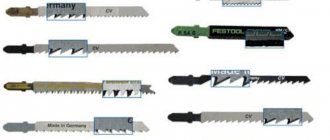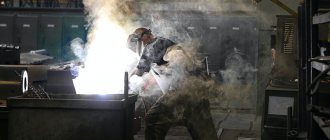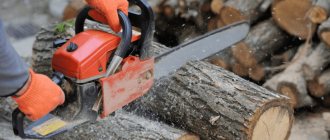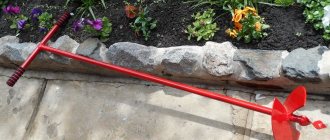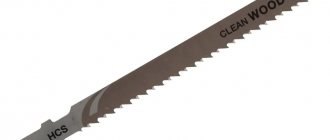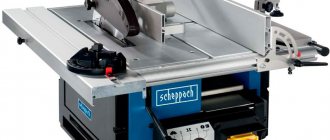The marking of jigsaw files serves to accurately characterize the equipment according to the manufacturing method and the features of use. On packaging, the product manufacturer, as a rule, indicates a more complete description. On the blade itself, the markings are more concise and include alphabetic and digital coding.
In fact, there is no single standard for marking saws, but most manufacturers try to adhere to the Bosch classification.
Marking of Bosch files
Bosch labels its files with an alphanumeric code. The code looks like this:
T101 B, U101 B, T344 D, T344 DP, T308 BF and so on. The letters and numbers in this code describe the characteristics of the file.
The first letter is the type of saw blade shank. This is most often the letter T and very rarely the letter U. Because the U-type shank is almost never used in jigsaws today. However, you can usually insert files with both types of shank into a jigsaw.
After the first letter there are three numbers, sometimes even 4, which indicate the length of the file and the type of its use. The first of these numbers always indicates the length of the file:
- 1 - file 10 or less centimeters long (up to 100 mm). The shortest files. The marking takes into account the length of the file with the shank. The marking number does not determine the exact length, but only its extreme range.
- 2 - file more than 100 mm long, but less than 120 mm. There are only two files with index 2 in the Bosch assortment, these are T244 D and T234 X, both 117 mm long.
- 3 - file with a length of 100 to 150 mm. The length of files with index 3 can vary greatly. T301 BCP, T308 BF are 117mm long and T344 DP is 152mm long.
- 7 - file more than 150 mm long.
- 10 - file more than 200 mm long.
Thus it turns out:
- T301 BCP - length over 100 mm.
- T101 AO - length 100 mm (or less).
The last two digits determine the type of file, for example:
- 01 indicate ground blades and undetected teeth (files for clean cuts). Most often, saws with index 01 are intended for clean sawing of wood.
- 02 - files for thermoplastic plastics - polypropylene, polymethyl methacrylate, PVC, polystyrene, polyamide, polyethylene. The numbers 02 are often combined with the letter H, for example T302 H.
- 08 denote a special tooth shape - a file for ultra-clean cuts, most often in wood.
- 11, 19 denote files with milled teeth. Most often, saws with these indices are intended for sawing wood.
- 13 denote a wavy knife.
- 18 and 21 indicate metal files. Files with index 18 have wavy, milled teeth. Files with index 21 have wavy, milled teeth, but of a different shape compared to index 18.
- 23 and 34 indicate files with variable (progressive) tooth pitch.
- 27 designate files for aluminum and similar soft, tough metals.
- 44 denotes files with a large set tooth (files for fast, rough cuts).
- 41 denotes files for abrasive materials - drywall, aerated concrete, fiber cement.
Thus it turns out:
- T301 BCP - length over 100 mm, saw blade for clean cuts.
- T101 AO - length 100 mm (or less), saw blade for clean cuts.
After the numbers there are letters that determine the tooth pitch of the file and the type of its use or material of manufacture. The first letter always indicates the tooth pitch size:
- G - less than 1 mm
- E - 1.4 and 1.5 mm
- A - less than 2 mm, closer to 2 mm.
- B - 2 - 3 mm
- C - 3 - 4 mm
- D - 4 - 5 mm
- X - file with variable tooth pitch. Closer to the shank the tooth is small, closer to the end the tooth is large (up to 5 mm).
Thus it turns out:
- T301 BCP - length over 100 mm, tooth pitch between 2-3 mm, saw blade for clean cuts.
- T101 AO - length 100 mm (or less), tooth pitch less than 2 mm, saw blade for clean cuts.
The following letters (second and further) indicate:
- F - composite sheet of two types of steel - HCS + HSS. Blade made of HCS steel, teeth made of HSS steel. Such files have a longer lifespan.
- O - file for figured cuts. It differs from ordinary files in that it has a narrower blade.
- R - with the reverse direction of the tooth - from the shank to the end of the blade.
- P - file with a thicker blade. If, for example, a file T301 B has a thickness of 1 mm, then a file with index P can have a thickness of up to 1.7 mm (at the shank).
- I - a saw with a non-directional (neither down nor up) tooth shape and a fine tooth pitch. Recommended for sawing thin laminated materials, such as laminate.
- S - file for stainless steel sheets.
- BC – variable tooth pitch, so-called “Japanese tooth”.
- RIFF is a grained carbon coating. File for sawing ceramic tiles.
- H - saw blade for sawing thermoplastic plastics, such as PVC.
- HM - teeth made of carbide material. Saw for sawing hard materials with abrasive filler, such as Corian, Varicor, plasterboard, aerated concrete, fiberglass, carbon fiber.
- AW (or 13 A ) is not even a file, but a wave-shaped knife. For cutting soft materials - cardboard, polystyrene, rubber, etc.
Thus it turns out:
- T301 BCP - length more than 100 mm, variable tooth pitch (Japanese tooth), saw blade for clean cuts, blade of increased thickness.
- T101 AO - length 100 mm (or less), tooth pitch less than 2 mm, file for clean cuts, file for figure sawing.
On Bosch files, markings are applied to the shank of the file. And on the blade of the file there is a text hint:
The T308 BP marking means that this is a file with a length of more than 100 mm, its tooth pitch is between 2 and 3 mm, and this file has an increased thickness.
The text hint “Precision for wood” means that this is a saw for precise angular cuts. That is, with this saw you can make an even cut at 90 or 45 degrees. If, of course, the jigsaw allows you to make an even cut.
Information on Bosch files on the official website.
Material for work
Wood. Most of the cutting blades are designed for working with wood, since the jigsaw was originally intended to interact with this particular material.
Today, there are several subgroups of saws depending on the work for which they are intended.
Fast operating speed
In some cases, it is not the quality that is important, it is the cutting speed that is important, so saws with the following characteristics can provide good speed:
- The cutting blade must be long enough, more than 6 cm.
- The teeth should be large.
- The divorce is minimal.
Neat cut
If you need to cut furniture panels or cut parquet boards, then a straight cutting line is required. Consequently, quality of work, rather than speed, now comes to the fore. To satisfy this requirement it is required:
- The teeth must be less than 4 mm.
- Divorce should be minimal.
Openwork cut
In order for the working material to have intricate shapes, it is necessary to use special files that have the following characteristics:
- The width of the cutting blade is up to 4 mm.
- The size of the teeth is up to 2 mm.
- The back side should be slightly inclined.
Marking of Makita files
Makita also labels its blades with an alphanumeric code. The code looks like this: B10S, B13, B16, L10, etc.
The letters mean:
- B - the length of the working part (with teeth) of the saw blade is less than 100 mm.
- L - the length of the working part (with teeth) of the file is 100 mm or more.
It's unclear what the numbers mean, and Makita's own codes are not very informative. But for most of its files, Makita indicates on the packaging compliance with Bosch coding.
However, this does not mean that such files exactly copy Bosch files, they are simply the closest match in terms of characteristics. This is due to the fact that Makita files are made in Japan, using their own technologies, and therefore they are not copies of Boshev files.
The packages of Makita files indicate the technical characteristics - dimensions, tooth pitch. This way you can navigate using this information. There is no information on files on the Makita website in a convenient form. You need to download a huge PDF file (almost 300 MB) - a catalog of accessories and look for information on files there. This catalog is not available on the Russian Makita website; it must be downloaded from the Japanese or American website. Catalog in English.
Classification Features
The demands placed on the instrument are currently very high. Productivity, speed of work, accuracy of the cut, and its evenness are important. In general, all variants of classifications of blades suitable for a jigsaw can be combined into several groups according to the following criteria:
Marking of DeWalt files
DeWalt also labels its blades with an alphanumeric code. The code looks like this: DT 2205, DT 2074, etc. DeWalt's own codes are not very informative, but for most of their files, DeWalt indicates the Bosch code on the packaging.
Since DeWalt files are made in Switzerland, as well as for Bosch, it is likely that these are mostly copies of Bosch files. Information on DeWalt files can be obtained from the official DeWalt Russia store.
Marking of Metabo files
Metabo also marks its files with a digital code. The code looks like this: 23651, 23640, etc.
Metabo's digital code is not as informative as DeWalt's and Makita's. Moreover, on the packaging they do not provide compliance with Bosch codes. So you need to open the Metabo website and look at the characteristics of the file by number. And on the website, for most of its files, Metabo indicates compliance in Bosch encoding. Metabo website.
Since Metabo files are made in Switzerland, as well as for Bosch, it is likely that these are mostly copies of Bosch files.
What it is?
A jigsaw file is a blade equipped with teeth of one type or another, fixed at one end to the movable rod of the tool. Since all materials have their own properties and characteristics, a large number of varieties are produced. They are designed to solve various problems, cutting certain materials. As a rule, craftsmen purchase sets of several types of cutting tools.
Selection criteria may be:
- The most popular and common types of cutting.
- Purpose for a particular material.
- Creation of a universal set that allows you to perform most types of processing.
Separate, specialized samples are also available for sale. They are purchased to perform specific work according to previously known parameters of the material and cutting conditions.
The choice of file type is determined by the user’s level of training, experience and knowledge. In order to avoid mistakes and choose the best option, you should study the features and characteristics of the cutting tool.
Summary
Of all the most popular manufacturers, Bosch has the most informative and convenient labeling of saw blades. It is no coincidence that it became the de facto standard. However, this does not mean that Bosch files are the best in the world. Moreover, Bosch does not produce files itself, but orders them from a third-party manufacturer in Switzerland. It is even possible that files for Bosch, Metabo, DeWalt and some other companies are made at the same factory in Switzerland.
Bosch provides the most information on files. She not only has a lot of information, but it is easy to find. There is information directly on the site pages, there is a good catalog in PDF format.
In second place is Devolt. In third place is the Metabo company - there is little information on peaks, but it is easy to find on their website. Metabo, on its website, indicates the thickness of its files.
The worst thing is with Makita. There is no information on files on the Russian official website. It is available on Japanese and American websites, but in a very inconvenient form.
Metals
A jigsaw cannot be called a suitable tool for working with metal. Firstly, the process progresses extremely slowly, secondly, there is a very large load on the tool, and thirdly, the teeth quickly become dull, causing the file to become unusable.
However, there are still special saws for metal. They are made of very strong steel, their teeth are small with a wavy pattern.
